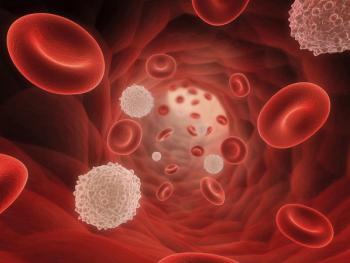
Moderately Hypofractionated Preoperative Radiotherapy Could be a Convenient Alternative to Conventionally Fractionated Radiotherapy for Soft Tissue Sarcomas
Investigators indicated that patients with soft tissue sarcomas should be counseled on receiving moderately hypofractionated radiotherapy vs conventionally fractionated radiotherapy, especially if it results in care at a sarcoma specialty center.
Given the tolerability of moderately hypofractionated preoperative radiotherapy, the treatment may be a convenient alternative vs conventionally fractionated radiotherapy for soft tissue sarcomas, according to findings from the phase 2 HYPORT-STS study (NCT03819985) published in Lancet Oncology.
At a mean post-operative follow-up of 24 months (interquartile range [IQR], 17-30) in a population of 120 patients who received hypofractionated radiotherapy preoperatively, 31% (95% CI, 24%-40%) of patients developed major wound complications with a median time of 37 days (IQR, 25-29) following surgery. Acute radiation toxicity of grade 3 or higher or on-treatment serious adverse effects (AEs) did not occur. Moreover, 3% of patients experienced late radiation toxicity of at least grade 3 at 6 months or more after surgery.
The single-center, open-label study was conducted at a tertiary cancer center, namely MD Anderson Cancer Center. Eligible patients needed to be 18 years of age or older with a life expectancy of over 6 months and an ECOG performance status of 3 or less. Patients were also required to have pathologically confirmed soft tissue sarcoma and be candidates for complete macroscopic resection of primary disease.
Patients were treated with preoperative radiotherapy at a total dose of 42.75 Gy in 15 fractions of 2.85 Gy per day over the course of 3 weeks. The trial’s primary end point was major wound complication within 120 days of surgery, defined at secondary operation, readmission for wound care, invasive procedures for wound care, deep wound packing of an area of at least 2 cm, prolonged dressing changes, surgery revision of a split-thickness skin graft, or wet dressings for over 4 weeks. Additionally, secondary outcomes included local recurrence-free survival, time to local relapse, acute radiation toxicity, and late radiation toxicity.
One hundred and twenty patients enrolled on the study of 157 who were considered for eligibility. Preoperative radiotherapy was administered at a median time of 20 days (IQR, 18-21) and most tumors were intermediate- or high-grade (73%). Moreover, 21% of patients had their wounds closed by primary closure and 79% had a plastics or reconstructive surgery specialist play a part in wound closure.
The average patient age was 60 years (range, 48-69) and 58% were men. Most patients had a tumor of the lower extremity (65%), while others had tumors of the upper extremity (17%) and trunk (18%). The most common tumor histopathologies were unclassified pleomorphic sarcoma (22%), myxoid liposarcoma (14%), non-myxoid liposarcoma (13%), and myxofibrosarcoma (13%). Almost half of all patients received intensity-modulated or volumetric-modulated arc radiotherapy (48%) and three-dimensional conformal radiotherapy (46%).Surgical resection occurred at a median interval of 5.7 weeks (IQR, 4.6-6.4) following the last fraction of radiotherapy.
Among patients who developed wound complications, 1 had disease of the upper extremity, 8 had disease of the trunk, and 28 of the lower extremity. In the lower extremity cohort of 28 patients, 82% had proximal and 18% had distal tumors. Eight additional patients had complications that were not thought to be major and included wound-edge necrosis that required sulfadiazine cream to help with healing (n = 1), the necessity of prolonged dry dressing (n = 4), and oral antibiotics (n = 3). Moreover, 38% of patients had wound complications of any severity.
Data from the univariable analyses indicated that significantly fewer patients with upper extremity tumors developed wound complications compared with those who had disease of the lower extremity or trunk. Development of major wound complication was not associated with factors such as age, sex, body mass index, tobacco smoking status, and ECOG performance status.
In a population of 119 patients who were evaluated for local control, 5% were found to have locally relapsed at a median follow-up of 16 months. A total of 4 relapses were found to occur in the radiotherapy field, 1 was at the field edge, and 1 was outside the radiotherapy field. Amputation was required in 1 patient for local recurrence who was free from disease 10 months after relapse. The 30-month actuarial recurrence-free survival rate was 93% (95% CI, 86%-97%).
In terms of safety, late grade 3 or higher radiation toxicity included femur fractures necessitating surgical stabilization (n = 2), severe lower extremity lymphedema requiring lymphatic bypass (n = 1), and major wound complication necessitating multiple surgeries (n = 1). A total of 12 patients had died at the time of the analysis, with 9 relating to sarcoma and 3 being unrelated.
Reference
Guadagnolo BA, Bassett R, Mitra D, et al. Hypofractionated, 3-week, preoperative radiotherapy for patients with soft tissue sarcomas (HYPORT-STS): a single-centre, open-label, single-arm, phase 2 trial. Lancet Oncol. Published online November 4, 2022. doi:10.1016/S1470-2045(22)00638-6
Newsletter
Stay up to date on recent advances in the multidisciplinary approach to cancer.

















































































